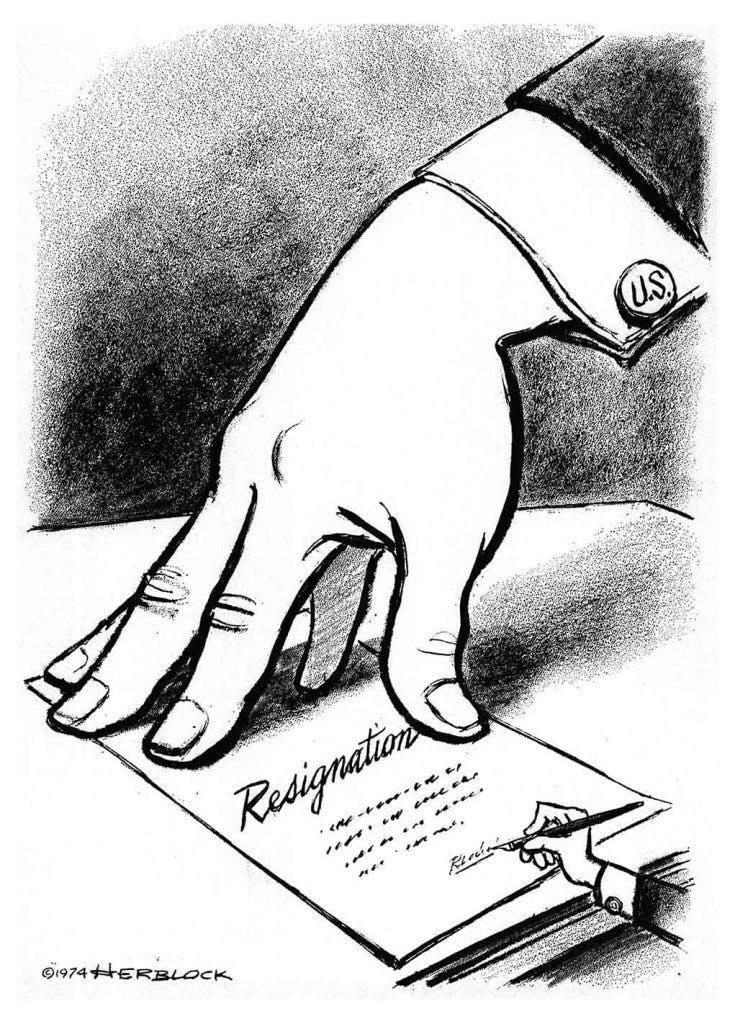Herblock, Watergate Cartoons, 1973–1974
Use this primary source imagery to analyze major events in history.
Suggested Sequencing
- Use this Primary Source with the Richard Nixon and Watergate Narrative; the Barbara Jordan and Watergate Decision Point; the Nixon Tapes: The “Smoking Gun” Tape, 1972 Primary Source; and the Barbara Jordan, Speech on Impeachment, July 25, 1974 Primary Source to discuss the controversy of the Watergate scandal and Nixon’s resignation.
Introduction
Herbert Lawrence Block, who signed his cartoons as Herblock, was an editorial cartoonist for the Washington Post from the mid-1940s until his death in 2001. Although Block had always been critical of President Richard Nixon, he found new material during the Watergate controversy with which to satirize the president. Starting in 1973, Block published a number of cartoons that kept the public updated on the unfolding scandal. In June 1973, the first of Nixon’s advisors accused the president of involvement in the cover up of the break-in at the Watergate office complex, the location of the Democratic National Committee headquarters. The following year, it was revealed that all conversations within the Oval Office were automatically recorded. Nixon refused to hand over the tapes to investigators, citing executive privilege. He argued the tapes contained confidential information that would impede the government and pose a security risk if released. In November 1973, Nixon famously declared “I am not a crook” at a press conference. However, within a few months, Nixon was deemed an “unindicted co-conspirator” by a grand jury and many of his closest aides were found guilty of various illegal activities. On July 27, the House Judiciary Committee recommended impeachment. Nixon resigned on August 9, 1974.
Sourcing Questions
- Who created these cartoons?
- Why did Block use cartoons to depict the Watergate scandal?
- What ultimately caused Nixon to resign?

Figure 1: Nixon Awash in His Office, June 26, 1973. (Credit: A 1973 Herblock Cartoon, © The Herb Block Foundation)

Figure 2: I Am Not a Crook, May 24, 1974. (Credit: A 1974 Herblock Cartoon, © The Herb Block Foundation)

Figure 3: Nixon, “ Unindicted Co-Conspirator,” July 14, 1974. (credit: A 1974 Herblock Cartoon, © The Herb Block Foundation)
Comprehension Questions
- (Figure 1) What do you notice about this image?
- (Figure 1) Why did Block portray Nixon in this manner?
- (Figure 2) What is Nixon hanging between?
- (Figure 2) What was Block implying with this cartoon?
- (Figure 3) What do you notice about this image? Note that the names on the chairs are of aides and other figures in the Nixon administration.
- (Figure 3) What do you think Block was trying to convey with this image?
Historical Reasoning Questions
- President Nixon claimed executive privilege during the Watergate investigation and refused to hand over the Oval Office tapes. Do you think the release of the Oval Office tapes represented a security issue? Explain your response.
- Read the Bill of Rights Institute’s short summaries of the impeachment cases against Presidents Andrew Johnson, Bill Clinton, and Donald Trump, none of whom were removed from office. How would you compare Nixon’s misdeeds with those of Johnson, Clinton, and Trump? Explain your answer.
Source: https://www.loc.gov/exhibits/herblocks-history/crook.html
